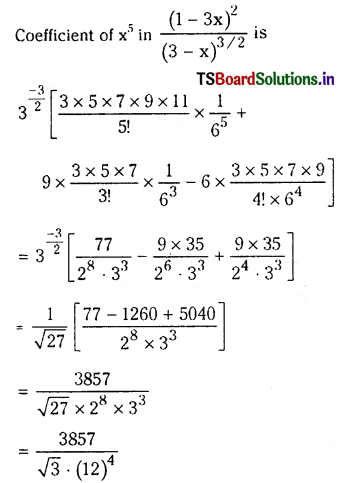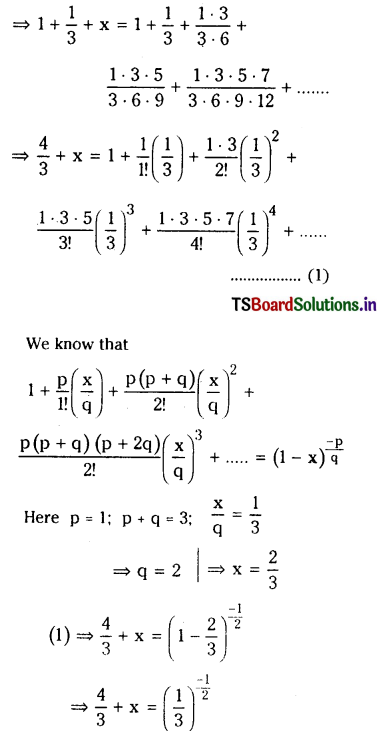Students must practice this TS Intermediate Maths 2A Solutions Chapter 6 Binomial Theorem Ex 6(b) to find a better approach to solving the problems.
TS Inter 2nd Year Maths 2A Solutions Chapter 6 Binomial Theorem Ex 6(b)
I.
Question 1.
Find the set of vaines of x for which the binomial expansions of the following are valid.
i) (2 + 3x)\(\frac{-2}{3}\)
ii) (5 + x)\(\frac{3}{2}\)
iii) (7 + 3x)-5
iv) (4 – \(\frac{x}{3}\))\(\frac{-1}{2}\)
Solution:
We know that
(2 + 3x)\(\frac{-2}{3}\) = 2\(\frac{-2}{3}\) (1 + \(\frac{3}{2}\)x)\(\frac{-2}{3}\)
The expansion is valid only when |\(\frac{3}{2}\) x| < 1
⇒ |x| < \(\frac{2}{3}\)
⇒ x ∈ \(\left(\frac{-2}{3}, \frac{2}{3}\right)\).
ii) We know that (5 + x)3/2
= 53/2 (1 + \(\frac{x}{5}\))3/2
The expansion is valid only when
|\(\frac{x}{5}\)| < 1
⇒ |x| < 5
⇒ x ∈ (- 5, 5).
iii) We know that
(7 + 3x)-5 = 7-5 (1 + \(\frac{3 x}{7}\))-5
The expansion is valid only when |\(\frac{3 x}{7}\)| < 1
⇒ |x| < \(\frac{7}{3}\)
⇒ x ∈ \(\left(\frac{-7}{3}, \frac{7}{3}\right)\)
iii) We know that (4 – \(\frac{x}{3}\))\(\frac{-1}{2}\)
= \(4^{\frac{-1}{2}}\left(1-\frac{x}{12}\right)^{\frac{-1}{2}}\)
The expansion is valid only when |\(\frac{x}{12}\)| < 1
⇒ |x| < 12
⇒ x ∈ (- 12, 12).
![]()
Question 2.
i) 6th term of (1 + \(\frac{x}{2}\))-5
ii) 7th term of (1 – \(\frac{x^2}{3}\))-4
iii) 10th term of (3 – 4x)\(\frac{-2}{3}\)
iv) 5th term of (7 + \(\frac{8 y}{3}\))\(\frac{7}{4}\)
Solution:
i) General term in the expansion of (1 + x)-n is
Tr+1 = (- 1)r . n+r-1Cr . xr
∴ 6th term of (1 + x)-5 is
T6 = (- 1)5 . 9C5 (\(\frac{x}{2}\))-5 (∵ n = r = 5)
= \(\frac{-63}{16}\) x5.
ii) General term in the expansion of (1 + x)-n is
Tr+1 = (- 1)r . n+r-1Cr . xr
7th term in the eapansion of (1 – \(\frac{x^2}{3}\))-4 is
T7 = \({ }^9 C_6\left(\frac{x^2}{3}\right)^6\) (∵ n – 4; r = 6)
= \(\frac{28}{243}\) x12
iii) We know that
(3 – 4x)\(\frac{-2}{3}\) = \(3^{\frac{-2}{3}}\left(1-\frac{4 x}{3}\right)^{\frac{-2}{3}}\)

iv) We know that (7 + \(\frac{8 y}{3}\))\(\frac{7}{4}\)

![]()
Question 3.
Write down the first 3 terms In the expansion of
i) (3 +5x)\(\frac{-7}{3}\)
ii) (1 + 4x)-4
iii) (8 – 5x)\(\frac{2}{3}\)
iv) (2 – 7x)\(\frac{-3}{4}\)
Solution:
i) \((3+5 x)^{\frac{-7}{3}}=3^{\frac{-7}{3}}\left(1+\frac{5 x}{3}\right)^{\frac{-7}{3}}\)
We know that

ii) We know that
(1 + x)-n = 1 – nx + \(\frac{\mathrm{n}(\mathrm{n}+1)}{2 !}\) x2 – ………….
∴ (1 + 4x)-4 = 1 – 4 (4x) + \(\frac{4(5)}{2}\) (4x)2 – …………..
= 1 – 16x + 160x2 – ……………
∴ The first 3 terms are 1, – 16x, 160x2.
iii) (8 – 5x)\(\frac{2}{3}\)

iv) \((2-7 x)^{\frac{-3}{4}}=2^{\frac{-3}{4}}\left[1-\frac{7 x}{2}\right]^{\frac{-3}{4}}\)
We know that

![]()
Question 4.
Find the general term ((r + i)th term) in the expansion of
i) (4 + 5x)\(\frac{-3}{2}\)
ii) (1 – \(\frac{5 x}{3}\))-3
iii) (1 + \(\frac{4 x}{5}\))\(\frac{5}{2}\)
iv) (3 – \(\frac{5 x}{4}\))\(\frac{-1}{2}\)
Solution:
i) We know that

ii) General term in the expansion (1 – x)-n is

iii) General term in the expansion of (1 + X)p/q is

iv) We know that

![]()
II.
Question 1.
Find the coefficient of x10 in the expansion of \(\frac{1+2 x}{(1-2 x)^2}\).
Solution:
We know that
\(\frac{1+2 x}{(1-2 x)^2}\) = (1 + 2x) (1 – 2x)-2
= (1 + 2x) [1 + 2(2x) + 3 (2x)2 + 4 (2x)3 + …………. + 10 (2x)9 + 11 (2x)10 + …………]
∴ The coefficient of x10 in \(\frac{1+2 x}{(1-2 x)^2}\) is
= 11 (210) + 10 (2) (29)
= 210 (11 + 10)
= 21 × 210.
Question 2.
Find the coefficient of x4 in the expansion of (1 – 4x)-3/5.
Solution:
General term in the expansion of (1 – X)\(\frac{-p}{q}\) is

Question 3.
i) Find the coefficient of x5
ii) Find the coefficient of x8 in (1 nt)2
iii) Find the coefficient of x in (2+3×9
Solution:
i) We know that
\(\frac{(1-3 x)^2}{(3-x)^{\frac{3}{2}}}=(1-3 x)^2\left[3-\left.x\right|^{\frac{-3}{2}}\right.\)


![]()
ii) We know that \(\frac{(1+x)^2}{\left(1-\frac{2}{3} x\right)^3}=(1+x)^2\left[1-\frac{2}{3} x\right]^{-3}\)

iii) We know that
\(\frac{(2+3 x)^3}{(1-3 x)^4}\) = (2 + 3x)3 [1 – 3x]-4
= (8 + 36x + 54x2 + 27x3) [1 + 4C (3x) + 5C2 (3x)2 + 6C3 (3x)3 + ……….. + (r+3)Cr (3x)r + …………..]
Clearly the coefficient of xr in above expansion is
8 (r+3)Cr 3r + 36 (r+2)Cr-1 3r-1 + 54 (r+1)Cr-2 3r-2 + 27 rCr-3 3r-2
for coefficient of x7, put r = 7
∴The coefficient of x7 in \(\frac{(2 x+3)^3}{(1-3 x)^4}\) is
8 10C7 37 + 36 9C6 36 + 54 8C5 35 + 27 7C4 34 = 8 10C3 37 + 36 9C3 36 + 54 8C3 35 + 27 7C3 34.
![]()
Question 4.
Find the coefficient of x3 in the expansion of \(\frac{\left(1+3 x^2\right)^{\frac{3}{2}}}{(3+4 x)^{\frac{1}{3}}}\).
Solution:
\(\frac{\left(1+3 x^2\right)^{\frac{3}{2}}}{(3+4 x)^{\frac{1}{3}}}\) = (1 + 3x)3/2 (3 + 4x)-1/3

![]()
III.
Question 1.
Find the sum of the infinite series:
i) 1 + \(\frac{1}{3}+\frac{1 \cdot 3}{3 \cdot 6}+\frac{1 \cdot 3 \cdot 5}{3 \cdot 6 \cdot 9}\) + ………….
ii) 1 – \(\frac{4}{5}+\frac{4 \cdot 7}{5 \cdot 10}-\frac{4 \cdot 7 \cdot 10}{5 \cdot 10 \cdot 15}\) + ………….
iii) \(\frac{3}{4}+\frac{3 \cdot 5}{4 \cdot 8}+\frac{3 \cdot 5 \cdot 7}{4 \cdot 8 \cdot 12}\) + …………
iv) \(\frac{3}{4 \cdot 8}-\frac{3 \cdot 5}{4 \cdot 8 \cdot 12}+\frac{3 \cdot 5 \cdot 7}{4 \cdot 8 \cdot 12 \cdot 16}\) – …………..
Solution:
i) Let y = 1 + \(\frac{1}{3}+\frac{1 \cdot 3}{3 \cdot 6}+\frac{1 \cdot 3 \cdot 5}{3 \cdot 6 \cdot 9}\) + ………….

ii) Let y = – \(\frac{4}{5}+\frac{4 \cdot 7}{5 \cdot 10}-\frac{4 \cdot 7 \cdot 10}{5 \cdot 10 \cdot 15}\) + ………….

![]()
iii) \(\frac{3}{4}+\frac{3 \cdot 5}{4 \cdot 8}+\frac{3 \cdot 5 \cdot 7}{4 \cdot 8 \cdot 12}\) + …………

iv) Let y = \(\frac{3}{4 \cdot 8}-\frac{3 \cdot 5}{4 \cdot 8 \cdot 12}+\frac{3 \cdot 5 \cdot 7}{4 \cdot 8 \cdot 12 \cdot 16}\) – …………..

![]()
Question 2.
If t = \(\frac{4}{5}+\frac{4 \cdot 6}{5 \cdot 10}+\frac{4 \cdot 6 \cdot 8}{5 \cdot 10 \cdot 15}\) + ……….. ∞, then prove that 9t = 16.
Solution:
Given
t = \(\frac{4}{5}+\frac{4 \cdot 6}{5 \cdot 10}+\frac{4 \cdot 6 \cdot 8}{5 \cdot 10 \cdot 15}\) + ……….. ∞

Question 3.
If x = \(\frac{1 \cdot 3}{3 \cdot 6}+\frac{1 \cdot 3 \cdot 5}{3 \cdot 6 \cdot 9}+\frac{1 \cdot 3 \cdot 5 \cdot 7}{3 \cdot 6 \cdot 9 \cdot 12}+\ldots\) then prove that 9x2 + 24x = 11.
Solution:
Given x = \(\frac{1 \cdot 3}{3 \cdot 6}+\frac{1 \cdot 3 \cdot 5}{3 \cdot 6 \cdot 9}+\frac{1 \cdot 3 \cdot 5 \cdot 7}{3 \cdot 6 \cdot 9 \cdot 12}+\ldots\)

⇒ \(\frac{4}{3}\) + x = √3
⇒ 4 + 3x = 3√3
⇒ 16 + 9x2 + 24x = 27
⇒ 9x2 + 24x = 11.
![]()
Question 4.
If x = \(\frac{5}{(2 !) \cdot 3}+\frac{5 \cdot 7}{(3 !) \cdot 3^2}+\frac{5 \cdot 7 \cdot 9}{(4 !) \cdot 3^3}+\ldots \ldots\) then find the value of x2 + 4x.
Solution:
x = \(\frac{5}{(2 !) \cdot 3}+\frac{5 \cdot 7}{(3 !) \cdot 3^2}+\frac{5 \cdot 7 \cdot 9}{(4 !) \cdot 3^3}+\ldots \ldots\)

∴ (1) ⇒ 2 + x = \(\left(1-\frac{2}{3}\right)^{-\frac{3}{2}}\)
⇒ 2 + x = \(\left(\frac{1}{3}\right)^{\frac{-3}{2}}\)
⇒ 2 + x = √27
⇒ x2 + 4x = 23.
Question 5.
Find the sum to infinite terms of the series \(\frac{7}{5}\left(1+\frac{1}{10^2}+\frac{1 \cdot 3}{1 \cdot 2} \cdot \frac{1}{10^4}+\frac{1 \cdot 3 \cdot 5}{1 \cdot 2 \cdot 3} \cdot \frac{1}{10^6}+\ldots\right)\)
Solution:
Let y = \(\frac{7}{5}\left(1+\frac{1}{10^2}+\frac{1 \cdot 3}{1 \cdot 2} \cdot \frac{1}{10^4}+\frac{1 \cdot 3 \cdot 5}{1 \cdot 2 \cdot 3} \cdot \frac{1}{10^6}+\ldots\right)\)

![]()
Question 6.
Show that for any non-zero rational number x.
\(1+\frac{x}{2}+\frac{x(x-1)}{2 \cdot 4}+\frac{x(x-1)(x-2)}{2 \cdot 4 \cdot 6}+\ldots .\) = \(1+\frac{x}{3}+\frac{x(x+1)}{3 \cdot 6}+\frac{x(x+1)(x+2)}{3 \cdot 6 \cdot 9}+\ldots .\)
Solution:
L.H.S = \(1+\frac{x}{2}+\frac{x(x-1)}{2 \cdot 4}+\frac{x(x-1)(x-2)}{2 \cdot 4 \cdot 6}+\ldots .\)
